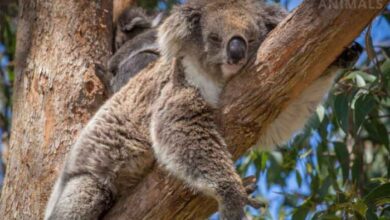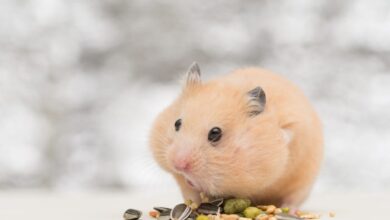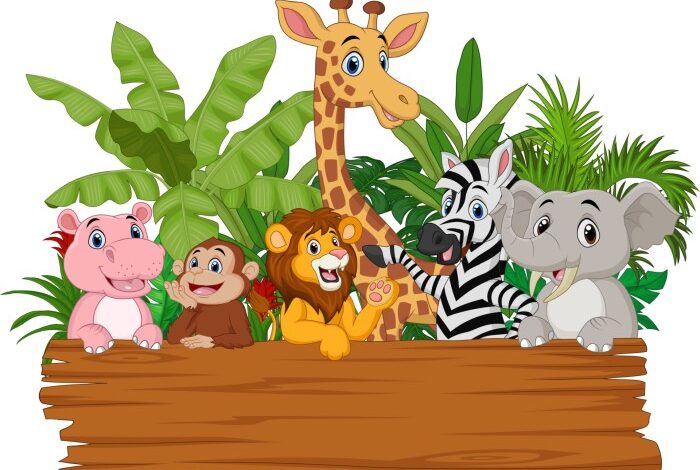
Wild Animals and a Mirror: Exploring Self-Awareness
Wild animals and a mirror – a seemingly simple concept, yet it opens a fascinating window into the minds of creatures vastly different from ourselves. Imagine a chimpanzee staring intently at its reflection, or a dolphin playfully interacting with its image in the water.
These interactions, while seemingly mundane, can reveal profound insights into animal intelligence, self-awareness, and even the very nature of consciousness. This exploration delves into the captivating world of animal cognition, exploring how their encounters with mirrors challenge our understanding of the animal kingdom.
From the intriguing “Mirror Test” used to assess self-recognition to the ethical considerations of using mirrors in animal research, we’ll examine the various ways these reflective surfaces have influenced our perception of animals and the complex questions they raise about their mental capabilities.
The Mirror Test and Animal Intelligence
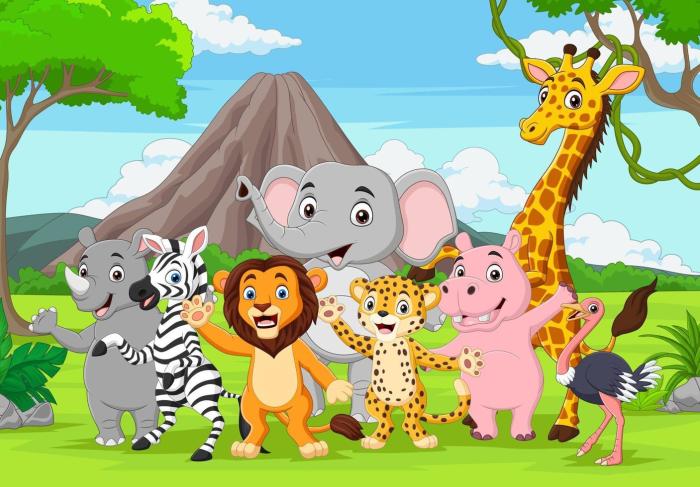
The Mirror Test, also known as the Mark Test, is a behavioral test used to assess self-awareness in animals. It’s a fascinating tool that has sparked much debate about the cognitive abilities of various species.
The Mirror Test and Its Significance
The Mirror Test was first devised by Gordon Gallup Jr. in 1970. The test involves placing an animal in front of a mirror and observing its behavior. The animal is then marked with a non-toxic dye or paint in a location that is visible only in the mirror.
Researchers then observe if the animal exhibits self-directed behavior, such as touching or investigating the mark on its body. The logic behind the test is that if an animal recognizes itself in the mirror, it should also recognize the mark as being on its own body and attempt to interact with it.
Results of the Mirror Test Across Species
The Mirror Test has been conducted on a wide range of animals, with varying results. * Primates:Chimpanzees, bonobos, orangutans, and gorillas have all shown evidence of self-recognition in the Mirror Test. They typically exhibit behaviors such as touching the mark on their bodies, inspecting the mark in the mirror, and even making facial expressions in response to the mark.
Watching a wild animal interact with a mirror can be fascinating. They seem to struggle with the concept of reflection, sometimes becoming aggressive or confused. It’s a reminder that we all have our own unique perspectives and interpretations of the world around us.
If you’re looking for some creative ways to show your loved ones you care this Valentine’s Day, check out this 14 days of gifts countdown to valentines day for some inspiration. Perhaps you can even gift them a mirror and see how they react – just be sure to keep a safe distance from any wild animals, of course!
Other Mammals
Some other mammals, such as dolphins, elephants, and magpies, have also shown signs of self-awareness in modified versions of the Mirror Test. However, these results are not as conclusive as those for primates.
I was watching a documentary about wild animals and how they react to mirrors. It’s fascinating to see how they perceive their reflection. It got me thinking about how we perceive our own reflection, and how that might be different for dads.
Maybe this Father’s Day, you could give your dad a fun gift related to his own reflection, like a fathers day idea that involves a personalized mirror or a photo booth experience. It’s a reminder that dads, like wild animals, have their own unique ways of seeing the world.
Birds
The Mirror Test has been used with some bird species, but the results are inconclusive. While some birds may show interest in their reflection, it’s difficult to determine if they recognize themselves in the mirror.
Limitations of the Mirror Test
The Mirror Test has been criticized for its limitations. * Species Specificity:The test may not be appropriate for all species. Some animals, such as dogs, may simply not be motivated to interact with a mirror.
Context Dependence
The results of the Mirror Test can vary depending on the animal’s age, experience, and the specific testing conditions.
Alternative Methods
There are alternative methods for assessing self-awareness, such as the “rouge test” (using a red dye), which have been shown to be more reliable in some species.
I was watching a documentary about wild animals and how they react to seeing their reflection in a mirror. It got me thinking about how we often take our own reflections for granted, but for many animals, it’s a completely foreign concept.
It made me realize that I should take a moment to appreciate the simple things in life, like being able to see myself clearly and reflect on who I am. Perhaps we could all learn a little something from those wild animals, and take the time to what are you thankful for in our own lives, even if it’s just a simple reflection in the mirror.
Alternative Methods for Assessing Self-Awareness
While the Mirror Test remains a popular tool, researchers are exploring other methods for assessing self-awareness in animals. * The Rouge Test:This test involves applying a red dye to the animal’s forehead and observing whether it touches or investigates the mark.
Self-Directed Behavior
Researchers also observe animals for other behaviors that may indicate self-awareness, such as grooming, playing, or using tools.
Cognitive Tasks
Researchers are developing increasingly complex cognitive tasks to assess self-awareness in animals. These tasks may involve understanding cause and effect, recognizing oneself in photographs, or demonstrating empathy.
The Role of Mirrors in Animal Behavior: Wild Animals And A Mirror
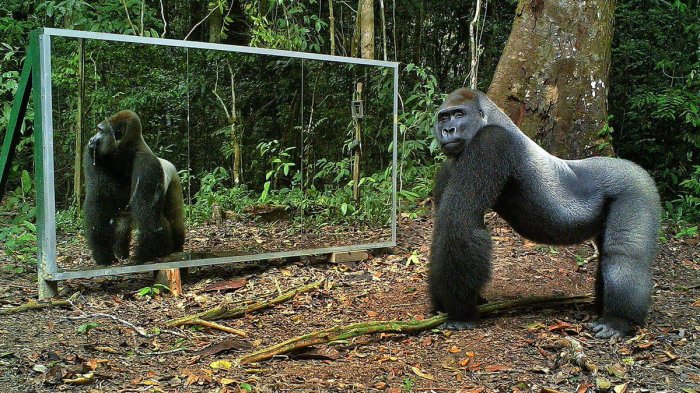
Mirrors, often used for self-reflection in humans, can also be valuable tools for studying animal behavior. By observing how animals interact with their reflections, researchers can gain insights into their cognitive abilities, social dynamics, and communication patterns.
Using Mirrors to Study Social Interactions and Communication
Mirrors can be used to study how animals interact with others, including their own species and different species. For instance, researchers can observe how animals react to their reflections, such as approaching them aggressively, displaying courtship behaviors, or ignoring them completely.
This can provide insights into the animals’ social hierarchy, territoriality, and communication signals.
- In primates, mirrors have been used to study the development of self-awareness. Chimpanzees, for example, have been shown to recognize themselves in mirrors, indicating a level of self-awareness similar to humans. This ability to recognize oneself is a key component of social cognition.
- Mirrors can also be used to study communication signals in animals. For example, researchers have observed that some birds use specific postures and vocalizations when interacting with their reflections, suggesting that these behaviors are part of their communication repertoire.
Applications of Mirrors in Animal Training and Rehabilitation
Mirrors can be used in various ways to train and rehabilitate animals.
- For example, mirrors can be used to encourage social interaction in animals that are shy or withdrawn. By placing a mirror in their enclosure, animals can see their reflection and learn to interact with others more comfortably.
- Mirrors can also be used to teach animals new behaviors. For example, trainers can use mirrors to help animals learn how to perform specific tasks, such as retrieving objects or performing tricks.
- In rehabilitation settings, mirrors can be used to help animals recover from injuries. For example, mirrors can be used to encourage movement in animals that have suffered from paralysis or other mobility issues.
Ethical Considerations of Using Mirrors in Animal Research
While mirrors can be a valuable tool for studying animal behavior, it’s crucial to consider the ethical implications of using them.
- For example, some animals may experience stress or anxiety when exposed to mirrors. It is important to ensure that the animals are comfortable and not distressed during the experiment.
- Researchers should also be aware of the potential for mirrors to influence animal behavior. For example, mirrors can create an artificial social environment that may not accurately reflect the animal’s natural behavior.
Artistic Representations of Animals and Mirrors
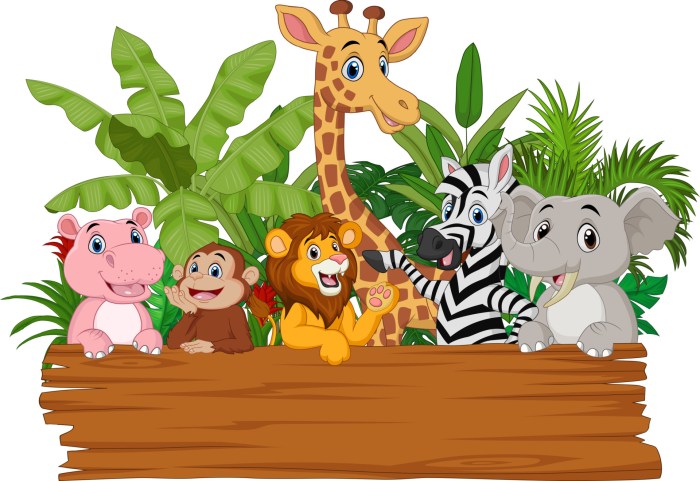
The reflection of animals in mirrors has captivated artists throughout history, offering a unique lens through which to explore themes of self-awareness, identity, and the animal-human relationship. From ancient cave paintings to contemporary installations, these representations offer a glimpse into the evolving perceptions of animals and their place in the world.
Examples of Artwork Depicting Animals and Mirrors, Wild animals and a mirror
Artists have used mirrors to create compelling and thought-provoking images of animals. Some examples of this include:
- “The Mirror” by Frida Kahlo (1939): This self-portrait depicts Kahlo with a monkey perched on her shoulder, gazing into a mirror. The monkey, representing her wild and untamed nature, contrasts with the human form, reflecting on themes of identity and duality. The mirror acts as a symbol of self-reflection, allowing the viewer to contemplate the complex relationship between the artist and her inner self.
- “The Elephant and the Mirror” by Salvador Dalí (1948): This surrealist painting depicts an elephant with elongated legs, reminiscent of stilts, standing before a mirror. The reflection in the mirror is distorted and fragmented, mirroring the elephant’s surreal and dreamlike form. The work challenges the viewer’s perception of reality and explores the relationship between the real and the imagined.
- “Mirror, Mirror” by Andy Warhol (1962): This silkscreen print features a series of repetitive images of a cat looking into a mirror. The repetition and the cat’s curious gaze create a sense of unease and introspection, exploring themes of identity and the nature of self-perception.
The multiple images of the cat suggest the fragmented and multifaceted nature of the self.

